Search the Special Collections and Archives Portal
Search Results
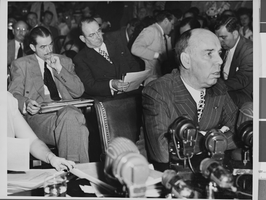
Photograph of Howard Hughes at hearing, Washington, August 06, 1947
Date
1947-08-06
Archival Collection
Description
Description given with photo: "Chairman Brewster Denies Collusion Charged By Hughes. Washington, D.C. Multi-millionaire plane-builder Howard Hughes, left, and his counsel, Thomas A. Slack, center, listen to chairman Owen Brewster, ( R ) of Me., right, of the Senate War Investigating Committee, testify before member of his committee. Senator Brewster denied under oath Howard Hughes' "blackmail" charge that Brewster had tried to make him merge the TWA with Pan-American Airways. -INP Photo by N.K. Benson- 8/6/47."
Image
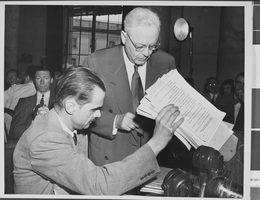
Photograph of Howard Hughes at hearing, Washington, August 08, 1947
Date
1947-08-08
Archival Collection
Description
Description given with photo: "Hughes And Dietrich Check Statements, Washington: Howard Hughes (seated) and Noah Dietrich, vice president of the Hughes Tool Co., look over their files and statements as the Senate War Investigating Subcommittee's hearing got under way, Aug. 8. Dietrich testified that a former chief of the Army Air Forces Procurement Offices said he would never buy an airplane from Hughes because he didn't like him. Credit (ACME) 8/8/47."
Image
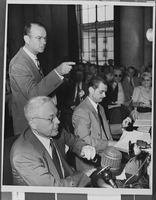
Photograph of Howard Hughes at hearing, Washington, August 08, 1947
Date
1947-08-08
Archival Collection
Description
Description given with photo: "Hughes, Attorneys, Resume Stand For Third Day. Washington, D.C. Noah Deitrich, seated, left, vice president of the Hughes Aircraft Co., told the Brewster Committee today that Maj. Gen. Oliver Echois, former AAF procurement (?) chief, refused to do business with Howard Hughes, right, because he "disliked" the multi-millionaire air-plane builder. Hughes' counsel, Thomas I. Slack, standing, is shown as he interrupted Deitrich's testimony to fire a question at the war contract probers. -INP Photo by G.B. Kress- 8/8/47."
Image
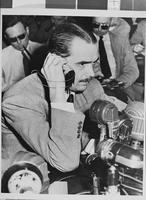
Photograph of Howard Hughes at hearing, Washington, August 07, 1947
Date
1947-08-07
Archival Collection
Description
Description given with photo: "Says Brewster Is "Greatest Trick Shot Artist In D.C. - Washington, D.C., Partially deaf, plane-builder Howard Hughes, above shown using a special hearing aid provided by the Senate War Investigating Committee now probing his war aircraft contracts. Hughes today fired a new volley of accusations at Chairman Brewster, ( R ) of Maine, calling toe Maine Senator the "greatest trick shot artist in Washington." The verbal volley was directed at Brewster's blanket denial that he offered to quash investigation of Hughes' war plane contracts if Hughes would merge his Trans-World Airlines with Pan-American Airways. -INP photo by N.K. Benson. 8/7/47."
Image
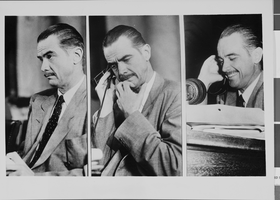
Photograph of Howard Hughes at hearing, Washington, August 08, 1947
Date
1947-08-08
Archival Collection
Description
Description given with photo: "Cogitation Concentration Jubilation, Washington, D.C. - Three interesting studies of plane-builder, movie-maker and headline-maker Howard Hughes as he returned to the witness stand before the Senate War Investigating Committee today to answer questions relating to his wartime plane-building contracts. During his testimony today, Hughes said he wishes to absolve shipbuilder Henry Kaiser from any criticism in connection with the 200-ton flying boat that is one of the issues in the current probe. Photograph by G.B. Kress. 8/8/47."
Image
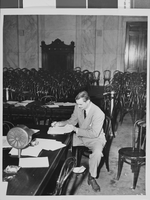
Photograph of Howard Hughes at hearing, Washington, August 11, 1947
Date
1947-08-11
Archival Collection
Description
Description given with photo: " "Shows Over" -- Return Engagement Promised! Washington, D.C. - In the Senate Caucus room, that a few days ago was packed to the doors, Howard Hughes, sits alone as he pens a statement to the press following the "surprise" postponement of Hughes war plane contract inquiry before the Senate War Investigating Subcommittee today, (Aug. 11). Creditline (ACME) 8/11/47."
Image
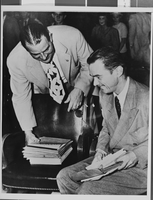
Photograph of Howard Hughes at hearing, Washington, August 11, 1947
Date
1947-08-11
Archival Collection
Description
Description given with photo: "Goodbye Until Now. 17th --- Wash D.C., An unidentified bodyguard (left) helps plane-builder Howard Hughes gather his papers after Senator Ferguson ( R ) Mich., suddenly announced that the Hughes war contract probe would be recessed until Now. 17. The committee's inability to locate Johnny Meyer, press agent for Hughes, for further questioning is given as the reason for the recess. Photo by A.E. Scott. 8/11/47."
Image
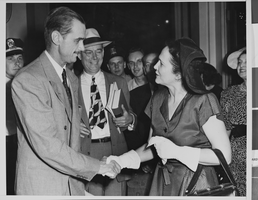
Photograph of Howard Hughes at hearing, Washington, August 09, 1947
Date
1947-08-09
Archival Collection
Description
Description given with photo: "The Senator's Lady Is Sympathetic, Washington, D.C. - Mrs. Claude Pepper, wife of the Senator from Florida, is shown shaking hands with Howard Hughes, millionaire plane-builder, as he emerged from the Senate War Investigating Committee hearing room after yesterday's session on the witness stand. Mrs. Pepper has been a constant spectator at the hearings. Standing beside Hughes is tome Slack, his counsel. Photo by G.B. Kress. 8/9/47.
Image
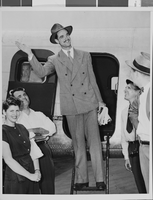
Photograph of Howard Hughes at hearing, Washington, August 13, 1947
Date
1947-08-13
Archival Collection
Description
Description given with photo: "Mr. Hughes Exits Smiling, Washington, D.C. - A different Howard Hughes from the harried, sometimes angry, man who faced the Senate War Investigating Committee last week, the millionaire plane-builder is shown waving a cheerful farewell to Washington and his admirers as he boarded his converted bomber at National Airport today for his return to California. Before taking off Hughes said he has no idea of the where-abouts of his elusive public relations man, John W. Meyer. Asked if he would be back in Washington when the committee reconvenes in November, he said: "Certainly." Photograph by N.K. Benson. 8/13/47."
Image
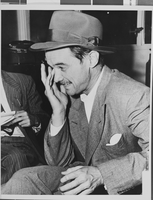
Photograph of Howard Hughes after hearing, Culver City, California, August 15, 1947
Date
1947-08-15
Archival Collection
Description
Description given with photo: "Tired Hughes Returns Home, Culver City, Cal. : Rubbing his tired eyes, Howard Hughes talks with reporters at an informal press conference at his plant in Culver City after his return flight from Washington. He said the hearings in which he participated were fair, and said the press and public made it "Impossible for Brewster to continue his Gestapo methods". Credit (ACME) 8/15/47."
Image
Pagination
Refine my results
Content Type
Creator or Contributor
Subject
Archival Collection
Digital Project
Resource Type
Year
Material Type
Place
Language
Records Classification
